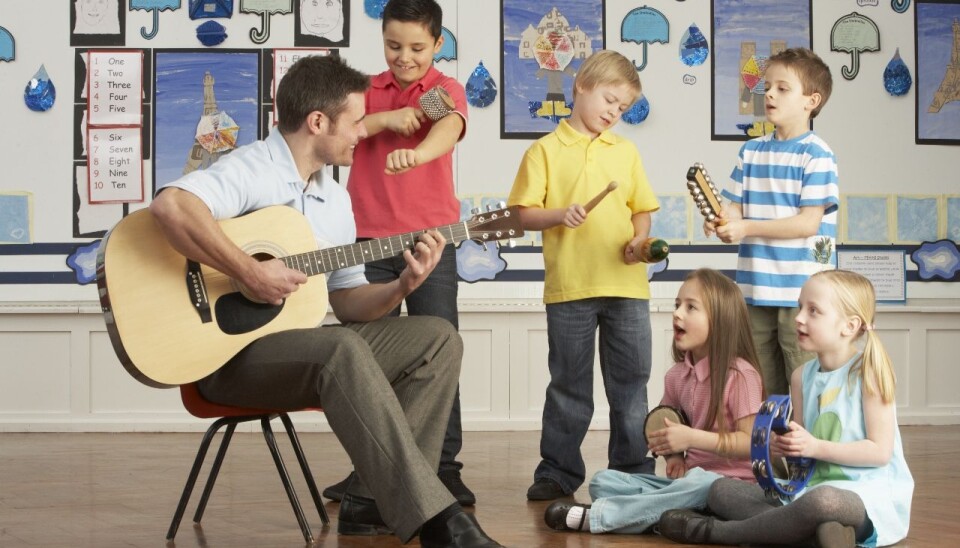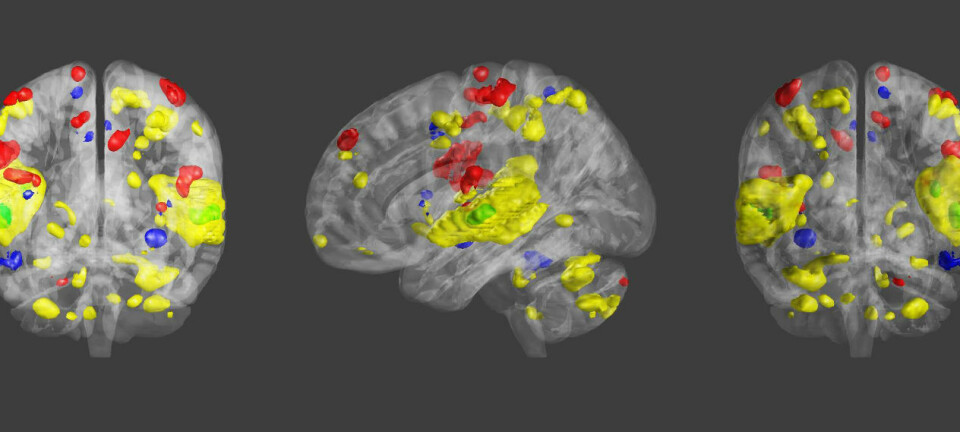
Music therapy reveals parenting skills
A test for assessing parenting skills has been developed. It is based on music therapy and reveals some of the fundamental family patterns that are otherwise not visible to outsiders.
A family of four is sitting in a music room, mother, father and the two children each with their own instrument: drums, piano, xylophone and the guitar. Next to them sits a music therapist, who asks them to start playing.
It doesn’t have to be a recognisable melody – or indeed a melody at all. Rather, the purpose of the jam session is to have the family members practice taking turns. The music therapist explains that the father is to start, and when he is ready, he can ask one of the others to continue. But words aren’t allowed.
Only body language and the sound of the instrument may be used to signal that it’s time for another family member to take over.
Are the family members keeping an eye on each other?
While the family is playing, the music therapist keeps an eye on the interaction. As a back-up, she has a video camera filming the entire session.
The way the families manage to play together in these exercises reflects such patterns as who takes initiative, who interrupts, who depends on others, and who might not even take interest in what the others are playing.
The therapist monitors the way the family members read each other and manage to listen to one another and express themselves clearly through the instruments.
“The way the families manage to play together in these exercises reflects such patterns as who takes initiative, who interrupts, who depends on others, and who might not even take interest in what the others are playing,” says Stine Lindahl Jacobsen, PhD and lecturer at Aalborg University.
“Compared to that of well-functioning families, communication in socially disadvantaged families is much more marred by mechanical dialogues and long awkward breaks, lack of variation and lack of dynamic movement.”
Music therapy is actually such an effective tool for revealing how well families function that Jacobsen, as part of her PhD research, has developed a test which reveals how well parents look after their children.
It isn’t as stressful for the families as psychological tests, where they are asked to fill in questionnaires with 110 questions they don’t understand. With music therapy, all they have to do is turn up and try to have fun with their children.
She developed the test on the basis of research into 18 families from a Danish family institution and 34 ordinary families, and a comparative study of the two groups. The test uses quantitative data and grades the families on a scale that is based on the norm.
The language barrier
The test, which is formally known as an estimation tool, is called APC (Assessment of Parenting Competencies). It’s been designed to measure two factors:
How well the parents in socially marginalised families take care of their children, and how the parents and the children perceive and react to one another.
The target group is families with children between the ages of five and twelve. This age group was selected because families with children of this age are particularly difficult to assess, since the children are big enough to have well-developed language.
“Children who have acquired language often use it to cover up problems,” she explains.
“Smaller children who haven’t yet acquired language tend to react more immediately, thus making it easier to assess the competencies of the parents in cases with smaller children.”
By using music therapy to assess how well the families function, Jacobsen has overcome the language obstacle:
“As soon as the children have language, it’s enormously difficult to assess their interaction with the parents, because they are loyal and are very conscious of the way they express themselves verbally,” she says.
“What I ask them to do in music therapy is not to speak. It doesn’t involve words, and this helps me see some of the patterns and habits that underlie the family interaction.”
Assesses emotional attachment
Jacobsen’s assessment tool can also tell her something about the attachment of a child to its parents. Attachment is about the relation between child and parent, which can be safe or unsafe.
Most often you will see an unsteady attachment in families that are socially marginalised.
The unsteady attachment can either be clingy and dependent, where the child is constantly tailing its parents, or independent and dismissive - to the parents as well as others.
“In music therapy there are already exercises designed to assess the child’s dependency, as one of the factors that can reveal something about the relationship between child and parent. And so, my method is appropriate for assessing the attachment between parent and child,” she says.
“It’s important to measure the attachment between child and parent, because different types of attachment require different types of efforts to help the family, and in some cases a very insecure and fluctuating attachment behaviour can raise the question whether there is actually anything there to build on. In other words, whether it makes any sense at all to keep the family together, considering the child’s needs.”
Cannot be considered in isolation
According to the researcher, her music therapy-based assessment is appropriate for assessing the interaction in socially disadvantaged families, because it is a quick method that doesn’t make any demands that the family can’t meet.
“It isn’t as stressful for the families as psychological tests, where they are asked to fill in questionnaires with 110 questions they don’t understand. With music therapy, all they have to do is turn up and try to have fun with their children,” says Jacobsen.
“But it naturally needs to be accompanied with other analyses of aspects such as context and network. However, I am certain that I can obtain reliable results about the family interaction in a short space of time compared to other methods.”
Well-documented method
An assessment of parent competency is designed to clarify whether the parents are able to take proper care of their child, ensuring the child’s development and well-being.
“My starting point was a wish to develop a well-documented method for assessing parenting skills. During my first music therapist internship seven years ago, I saw how difficult it was for my colleagues to get close to the families when they were doing parent assessments,” she says.
Children relax during music therapy
Jacobsen considered whether, being a music therapist, she wouldn’t have greater success making the children relax.
“The children relaxed when they came to music therapy, and when they had their guard down, I was free to do exercises with them which revealed some of the basic family patterns, which language would have allowed them to hide,” she says.
The exercises that she does in music therapy typically focus on the ability to communicate, express oneself, and read others.
“It may for instance be about taking turns to play without interrupting one another, or to alternate between playing loudly, and playing softly.”
It doesn’t have to sound good
The music therapy that Jacobsen uses to assess the families is an active form of music therapy where the families use instruments and singing to communicate.
“It doesn’t necessarily have to sound good and musicality isn’t a necessity, but the families need to participate actively. The reason is that the way the families communicate is far more interesting than precisely what they’re saying. In other words, the focus in this form of music therapy is on the form of the communication, rather than the content,” she says.
The families are asked to make exercises that are designed to reveal something about the way they interact. One of the exercises that Jacobsen uses is designed for practicing basic turn taking.
“It’s about listening, leading and following. Often either the parents or the children will be too passive in the beginning, but when they’re forced to take on the opposite role, they get the experience that they can do it.”
Music therapy improves communication
Jacobsen’s study shows that there’s more to music therapy than exposing problematic behaviour in families.
“In addition to the study of the assessment tool, APC, I have researched whether music therapy improves communication, empathy and stress levels in the test families – and it does. Their scores in my assessments show this, as do the various psychological questionnaires they are asked to fill in,” she says.
Jacobsen hasn’t researched why music therapy helps, but she has some ideas:
“I think it’s part of the reason is that the music is used to show the parents what the children need in a sensible way. Parents in this type of family often find it difficult to understand things when they are explained to them – they have to see it or feel it to understand it.”
“In music therapy I can illustrate how an exercise should be carried out, and as soon as I can tell that the family has understood the exercise, I pull out. In that way I can be a role model without overshadowing the parents.”
-----------------------------------
Read the Danish version of this article at videnskab.dk
Translated by: Iben Gøtzsche Thiele









